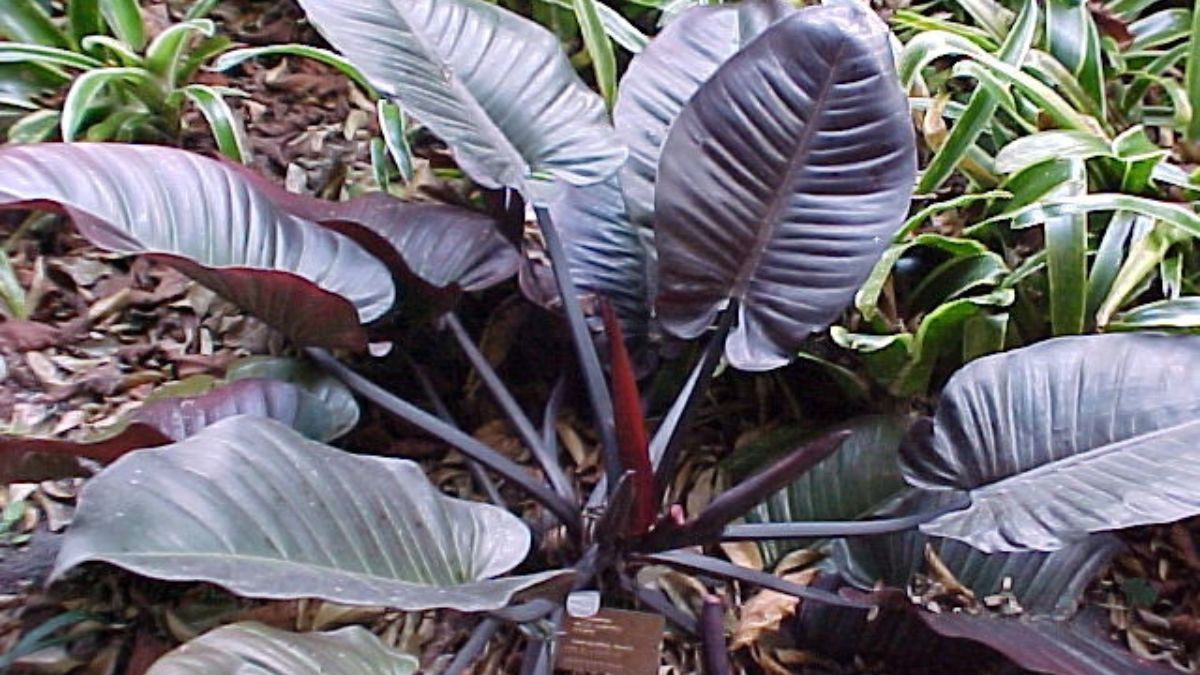Few houseplants command attention quite like the Philodendron Black Cardinal. With its deep burgundy to near-black foliage, compact growth habit, and velvety texture, this tropical gem has surged in popularity among plant collectors and interior designers alike. Whether you’re a seasoned plant parent or a curious beginner, understanding how to care for your Philodendron Black Cardinal ensures it stays healthy, vibrant, and visually stunning for years to come.
In this comprehensive guide, we’ll walk you through everything you need to know—from ideal lighting conditions and watering routines to propagation techniques and common troubleshooting tips. Plus, we’ve included a detailed comparison chart that pits the Black Cardinal against similar dark-leafed philodendrons so you can choose the perfect plant for your space.
Table of Contents
What Is a Philodendron Black Cardinal?
The Philodendron Black Cardinal (sometimes labeled Philodendron ‘Black Cardinal’) is a hybrid cultivar developed from selective breeding within the Philodendron genus, which belongs to the Araceae family. Unlike many vining philodendrons, the Black Cardinal is a self-heading (non-climbing) variety, meaning it grows in a dense, upright rosette rather than trailing or climbing.
Its most striking feature is its foliage. New leaves emerge in a rich copper or burgundy-red hue, gradually maturing into a deep, glossy black or near-black shade. The leaves are thick, leathery, and oval-shaped with a slightly heart-like base—typically 6 to 8 inches long at maturity. This plant rarely flowers indoors, but when it does, the inflorescence resembles a small white spadix wrapped in a green spathe, typical of aroids.
Native to tropical rainforests of Central and South America, the Black Cardinal thrives in warm, humid environments with dappled light—conditions you can easily replicate indoors with a few mindful adjustments.
Curious to learn more? Dive into the rest of our blog for helpful tips and insights!
Ideal Growing Conditions for Your Philodendron Black Cardinal
Light Requirements
The Philodendron Black Cardinal prefers bright, indirect light. Place it near an east- or north-facing window where it receives filtered sunlight throughout the day. Avoid direct afternoon sun (especially from south- or west-facing windows), as intense rays can scorch its dark leaves and cause irreversible damage.
While it tolerates lower light conditions better than many variegated plants, prolonged exposure to dim environments will slow its growth and dull its dramatic coloration. If you notice leggy stems or pale new growth, it’s a sign your plant needs more light.
Watering Needs
Water your Black Cardinal when the top 1–2 inches of soil feel dry to the touch. Overwatering is the most common cause of decline in this plant, leading to root rot—a silent killer that often goes unnoticed until leaves yellow or collapse.
Use room-temperature water and ensure your pot has drainage holes. Allow excess water to drain completely; never let the plant sit in standing water. During winter months, reduce watering frequency as growth naturally slows in cooler temperatures.
Humidity and Temperature
This tropical beauty thrives in humidity levels of 60% or higher. While it can adapt to average household humidity (40–50%), you’ll notice richer color and healthier growth with added moisture in the air. Use a humidifier, place the pot on a pebble tray filled with water, or group it with other plants to create a microclimate.
Keep temperatures between 65°F and 85°F (18°C–29°C). Avoid cold drafts, air conditioning vents, or sudden temperature drops below 55°F (13°C), which can stress the plant and cause leaf drop.
Soil and Potting
Use a well-draining, airy potting mix rich in organic matter. A blend of:
- 1 part high-quality potting soil
- 1 part orchid bark or perlite
- 1 part coco coir or peat moss
provides excellent aeration and moisture retention without becoming soggy. Repot every 1–2 years in spring, moving up only one pot size at a time. The Black Cardinal likes to be slightly root-bound, so avoid oversized containers.
Fertilizing Your Philodendron Black Cardinal
Feed your plant monthly during the growing season (spring through early fall) with a balanced, water-soluble fertilizer diluted to half strength (e.g., 10-10-10 or 20-20-20). Reduce or stop fertilizing in winter when growth slows.
Avoid over-fertilizing—excess salts can accumulate in the soil and burn roots, leading to brown leaf tips or stunted growth. Flush the soil with water every few months to prevent buildup.
Propagation Made Easy
The Philodendron Black Cardinal propagates best through division or stem cuttings.
Division Method (Best for Mature Plants):
During repotting, gently separate offshoots or clumps that have their own root systems. Pot each division in fresh soil and keep the soil consistently moist until new growth appears.
Stem Cutting Method:
- Select a healthy stem with at least one leaf and a node (the bump where roots emerge).
- Using sterilized scissors, make a clean cut just below the node.
- Place the cutting in water or moist sphagnum moss.
- Keep it in bright, indirect light. Roots typically appear in 2–4 weeks.
- Once roots are 1–2 inches long, transplant into soil.
Note: Unlike vining philodendrons, the Black Cardinal doesn’t produce long stems, so division is often more practical than cuttings.
Common Problems and Solutions
| Yellow leaves | Overwatering or poor drainage | Let soil dry out; check for root rot; repot if needed |
| Brown, crispy leaf edges | Low humidity or underwatering | Increase humidity; adjust watering schedule |
| Pale or green new leaves | Insufficient light | Move to a brighter location with indirect light |
| Drooping leaves | Underwatering or root stress | Water thoroughly; inspect roots for damage |
| Slow growth | Low light, cold temps, or lack of nutrients | Optimize light/temperature; fertilize during growing season |
The Black Cardinal is generally pest-resistant but can occasionally attract spider mites, mealybugs, or scale—especially in dry conditions. Wipe leaves with a damp cloth regularly and treat infestations early with insecticidal soap or neem oil.
Philodendron Black Cardinal vs. Similar Dark Philodendrons: A Comparison Chart
To help you distinguish the Black Cardinal from other dramatic dark-leafed philodendrons, here’s a side-by-side comparison of key traits:
| Leaf Color | Deep burgundy → near-black | Glossy dark green | Reddish-black, often with copper sheen | Bright lime green (not dark) |
| Growth Habit | Self-heading (rosette) | Self-heading | Vining/climbing | Self-heading |
| Leaf Texture | Thick, leathery, velvety | Smooth, glossy | Thin, slightly waxy | Smooth, soft |
| Mature Leaf Size | 6–8 inches | 10–12 inches | 8–10 inches (can grow larger) | 5–7 inches |
| Light Preference | Bright indirect | Bright indirect | Bright indirect to partial shade | Bright indirect |
| Rarity | Moderately common | Common | Rare to uncommon | Common |
| Beginner-Friendly? | Yes | Yes | Moderate (needs support) | Yes |
| Special Notes | Compact; ideal for shelves | Large, architectural presence | New leaves emerge bright red | Not dark-colored; included for contrast |
Note: Philodendron Moonlight is included to clarify a common misconception—it’s often grouped with dark varieties due to its popularity but features bright green foliage.
This chart highlights why the Black Cardinal stands out: its compact, non-vining form and intense black foliage make it perfect for tabletops, desks, or small spaces where dramatic color is desired without overwhelming growth.
Styling Tips for Your Philodendron Black Cardinal
Thanks to its bold color and sculptural form, the Black Cardinal doubles as living art. Here’s how to showcase it:
- Contrast with light backgrounds: Place it against white walls, light wood shelves, or pale ceramics to make its dark leaves pop.
- Pair with textured pots: Matte black, terracotta, or concrete planters complement its moody aesthetic.
- Group with lighter plants: Combine with a pothos, calathea, or string of pearls to create visual balance.
- Use as a focal point: Its upright growth makes it ideal for centering on coffee tables, entryway consoles, or bathroom vanities (if humidity is adequate).
Avoid overcrowding—this plant deserves space to be admired.
Is the Philodendron Black Cardinal Pet-Safe?
No. Like all philodendrons, the Black Cardinal contains calcium oxalate crystals, which are toxic to cats, dogs, and humans if ingested. Symptoms include mouth irritation, drooling, vomiting, and difficulty swallowing. Keep it out of reach of pets and small children, and wash hands after handling.
Where to Buy a Philodendron Black Cardinal
Due to its popularity, the Black Cardinal is widely available from:
- Reputable online plant retailers (e.g., Etsy shops with high ratings, specialty nurseries like Gabriella Plants or Canopy Plant Co.)
- Local plant stores and garden centers
- Plant swap groups or collector communities (Facebook, Reddit)
When purchasing, look for plants with firm, unblemished leaves and no signs of pests. Avoid specimens with yellowing leaves or soggy soil, which may indicate poor care or root issues.
Final Thoughts: Why the Philodendron Black Cardinal Deserves a Spot in Your Home
The Philodendron Black Cardinal isn’t just another houseplant—it’s a statement piece that brings depth, sophistication, and a touch of the tropics to any indoor space. With relatively low maintenance needs and striking visual appeal, it’s an excellent choice for both novice and experienced plant enthusiasts.
By providing bright indirect light, well-draining soil, consistent (but not excessive) watering, and moderate humidity, you’ll enjoy its dramatic foliage for years. And thanks to its compact, self-heading growth, it fits beautifully in apartments, offices, and minimalist interiors where space is at a premium.
Whether you’re building a lush indoor jungle or simply adding one bold accent plant, the Philodendron Black Cardinal delivers unmatched elegance with minimal fuss.












